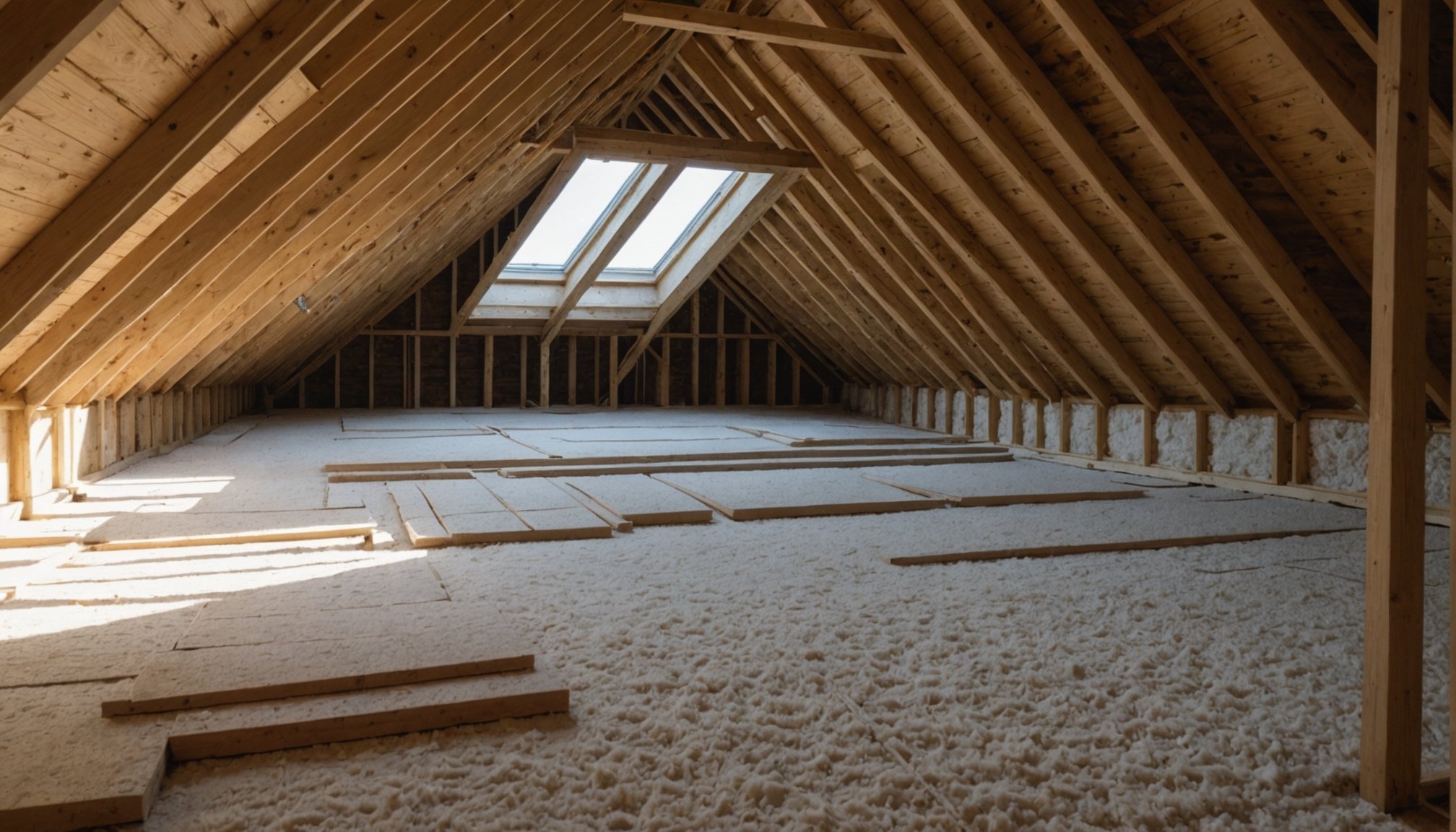Top Insulation Materials for UK Attics: How to Combat Winter Heat Loss Effectively
As the winter months approach, many homeowners in the UK are looking for ways to keep their homes warm and energy-efficient. One of the most effective methods to achieve this is by ensuring your attic is well-insulated. In this article, we will explore the top insulation materials for UK attics, their benefits, and how they can help you combat winter heat loss.
Understanding the Importance of Loft Insulation
Before diving into the various insulation materials, it’s crucial to understand why loft insulation is so important. Heat loss through the roof is one of the most significant ways energy is wasted in a home. According to energy efficiency experts, up to 25% of a home’s heat can be lost through the roof if it is not properly insulated.
Avez-vous vu cela : Essential Guidelines for Installing a Biomass Heating System in Your UK Rural Cottage
The Impact on Energy Bills
Proper loft insulation can significantly reduce your energy bills. Here’s what a homeowner had to say about their experience:
“Since we insulated our loft, we’ve noticed a substantial reduction in our energy bills. It’s not just about the cost; our home feels warmer and more comfortable during the winter months.”
Avez-vous vu cela : Top Native Plants for Crafting a Stunning Privacy Hedge in Your UK Front Yard
Types of Insulation Materials for UK Attics
There are several types of insulation materials available, each with its own set of benefits and drawbacks.
Rigid Foam Boards: PIR and XPS
Rigid foam boards, such as PIR (Polyisocyanurate) and XPS (Extruded Polystyrene), are highly regarded for their thermal efficiency and moisture resistance.
- PIR Foam Boards: Known for their high thermal performance and relatively lower cost compared to XPS, PIR foam boards are a popular choice. They offer excellent fire resistance and are less prone to melting and dripping when exposed to high temperatures.
- XPS Foam Boards: While XPS has robust compressive strength and minimal water absorption, it is less sustainable and more expensive. It can melt and drip when subjected to high temperatures, posing additional fire risks.
Table: Comparison of PIR and XPS Foam Boards
| Feature | PIR Foam Boards | XPS Foam Boards |
|---|---|---|
| Thermal Efficiency | High | High |
| Moisture Resistance | Excellent | Excellent |
| Cost | Lower than XPS | Higher |
| Fire Resistance | Better | Less |
| Sustainability | Less sustainable | Less sustainable |
| Water Absorption | Minimal | Less than 1% |
Fibreglass Insulation
Fibreglass is a common and cost-effective insulation material, particularly for cold lofts.
- Benefits: Fibreglass is versatile, cheap, and made from 40-60% recycled materials. It is easy to install and comes in rolls or batts.
- Drawbacks: Fibreglass can hold onto water and moisture, reducing its insulating properties and leading to mould and mildew growth. It also requires protective gear during installation to avoid skin and lung irritation.
Wool Insulation
Wool insulation, including natural materials like sheep’s wool and hemp, is highly regarded for its thermal and acoustic properties.
- Benefits: Wool insulation provides continuous insulation, absorbs up to 30% of its weight in water without compromising its insulating properties, and is fire-resistant. It is also the most eco-friendly option available.
- Drawbacks: Wool insulation is more expensive than other materials, costing around £19.75 per square meter, and is susceptible to pests due to its organic nature.
Vermiculite Insulation
Vermiculite is a granule/pebble-like loose-fill insulation that has been used in many UK homes.
- Safety Concerns: While vermiculite itself is safe, older vermiculite insulation may contain asbestos. It is less effective and efficient compared to modern insulation materials and can affect the value of your home if not replaced.
- Recommendation: If you have vermiculite insulation, it is advised to have it tested for asbestos and consider replacing it with more modern and efficient insulation materials.
Detailed List of Benefits and Drawbacks for Each Material
-
PIR Foam Boards
-
High thermal efficiency
-
Excellent fire resistance
-
Lower cost compared to XPS
-
Less sustainable
-
Minimal water absorption
-
XPS Foam Boards
-
Robust compressive strength
-
Minimal water absorption
-
Higher cost
-
Less sustainable
-
Melts and drips when exposed to high temperatures
-
Fibreglass Insulation
-
Cost-effective
-
Versatile and easy to install
-
Made from recycled materials
-
Holds onto water and moisture
-
Requires protective gear during installation
-
Wool Insulation
-
Excellent thermal and acoustic properties
-
Eco-friendly
-
Fire-resistant
-
More expensive
-
Susceptible to pests
-
Vermiculite Insulation
-
Less effective and efficient
-
May contain asbestos
-
Affects home value if not replaced
-
Safe if modern and asbestos-free
Practical Insights and Actionable Advice
Choosing the Right Insulation Material
When choosing the right insulation material for your attic, consider several factors:
- Budget: If you are on a tight budget, fibreglass or EPS (Expanded Polystyrene) might be the best options.
- Thermal Performance: For high thermal efficiency, PIR or XPS foam boards are ideal.
- Eco-Friendliness: If you are looking for an eco-friendly option, wool insulation is the best choice.
- Ease of Installation: Fibreglass and wool insulation are generally easy to install, while foam boards may require more expertise.
Installation Tips
- Wear Protective Gear: When installing fibreglass or other materials that release dust, wear protective gear to avoid skin and lung irritation.
- Ensure Proper Fit: Make sure the insulation material fits snugly between rafters to maximize its effectiveness.
- Seal Gaps: Seal any gaps or cracks in the roof to prevent air leaks and ensure the insulation works efficiently.
Maintenance and Safety
- Regular Checks: Regularly check your insulation for any signs of damage or deterioration.
- Asbestos Testing: If you have older vermiculite insulation, consider having it tested for asbestos to ensure safety.
Real-Life Examples and Anecdotes
Here’s an example of how proper insulation can make a significant difference:
“After insulating our loft with PIR foam boards, we noticed a significant reduction in our energy bills. The house feels warmer, and we no longer have cold spots in the bedrooms. It was a worthwhile investment that has paid off in just a few months,” said a satisfied homeowner.
Insulating your attic is a crucial step in maintaining a warm and energy-efficient home. By choosing the right insulation material based on your needs and budget, you can significantly reduce heat loss and lower your energy bills.
Final Tips
- Consult Experts: If you are unsure about the best insulation material or how to install it, consult with insulation experts.
- Consider Long-Term Benefits: While some insulation materials may be more expensive upfront, they can offer long-term benefits in terms of energy efficiency and cost savings.
- Check Local Incentives: Many local authorities offer incentives for home insulation projects, so it’s worth checking if you are eligible.
By following these guidelines and choosing the right insulation material for your UK attic, you can ensure a warm, comfortable, and energy-efficient home throughout the winter months.











